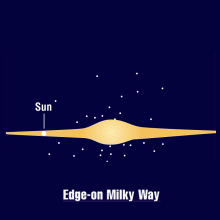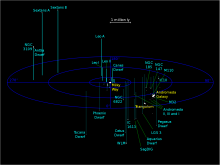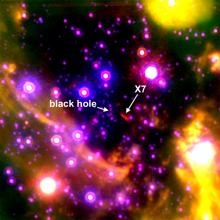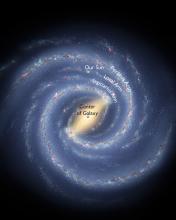You are here
The Milky Way

In summer, in a clear place with dark night skies, an irregular glowing band arcs high overhead. The ancients likened it to a stripe of milk spilled across the sky.
Today, we know that this band of light is the combined glow of countless millions of stars in the flat disk of the Milky Way galaxy, our galactic home. The Milky Way is a spiral galaxy, so seen from above it would look like a pinwheel. The Milky Way consists of a bulge of stars in the core, probably a thick bar of stars flanking the core, and bright spiral arms wrapping around the core. This pinwheel is about 100,000 light-years in diameter, but only about 2,000 light-years thick, so it forms a thin disk. Our solar system is about 27,000 light-years from its center.
Our knowledge of the Milky Way's structure has taken centuries to compile, and astronomers continue to learn about it today.
In the 18th century, William Herschel suggested that the Sun resides in a rotating disk of stars. Since the band of the Milky Way is roughly equally bright all around the sky, Herschel suggested that the Sun is in the middle of it.
What Herschel didn't know is that our galaxy is full of dust. Elements like silicon, carbon, and iron are forged in the cores of stars and released into space late in the stars' lives. The dust obscures our view. The problem is like being dropped into a forest on a foggy day. You can see many trees in all directions, but you can't see very far in any direction.
Fortunately, the dust is concentrated in the Milky Way's disk. The disk is surrounded by a roughly spherical halo that is relatively free of dust. But the halo contains about 200 globular star clusters, which are ball-shaped groups of hundreds of thousands of stars.
In 1917, Harlow Shapley noted that most of the globular clusters appeared on one side of the sky. Based on this, he proposed that the Sun is near the edge of the galaxy's disk. He reasoned that the spherical halo of globulars is centered on the core of the Milky Way's disk. This meant that, from our off-centered vantage point, we see more globular clusters on one side of the sky.
In spite of this breakthrough, the dimensions of the Milky Way and any detailed idea of its structure were poorly known. Most modern information came after the beginnings of radio and infrared astronomy. The reason is simple. Like visible light, radio and infrared are forms of energy, but with longer wavelengths. These wavelengths pass through the dust in the Milky Way, so they can reach radio and infrared telescopes on Earth. Recall that on a foggy day, your car headlights have a tough time penetrating the fog, but your car's radio works just fine.
Radio astronomy provided the first new key to studying the disk of the Milky Way. Everything in the galaxy orbits the center of the disk. Objects nearer the center orbit faster than objects orbiting farther out. So by measuring the motions of many clouds of gas and dust, radio astronomers gave us our first murky insight into the structure of the galaxy's disk.
Today, we know that the disk contains between 200 billion and 400 billion stars. A black hole perhaps four million times as massive as the Sun sits in the middle of the Milky Way. It's surrounded by giant stars, clouds of dust, and magnetic fields that make the core a dynamic place.
The galaxy's main constituent is invisible "dark matter" that permeates the halo, extending several hundred thousand light-years in all directions. This material reveals its presence only through its gravitational pull on the Milky Way's visible stars and gas clouds. Dark matter may account for 90 percent of the Milky Way's total mass.





